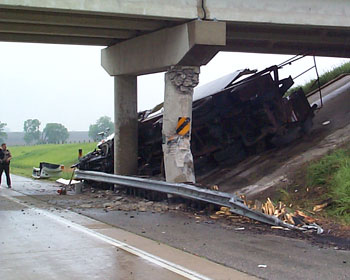

MPC Research Reports |
| Title: | Evaluation and Mitigation of Vehicle Impact Hazards for Overpasses |
| Authors: | Nadim I. Wehbe, Xiao Qin, Brett Tigges, Zhao Shen, and Abdullah Boudaqa |
| University: | South Dakota State University |
| Publication Date: | Dec 2017 |
| Report #: | MPC-17-339 |
| Project #: | MPC-397 |
| TRID #: | 01661646 |
| Keywords: | bents, columns, finite element method, highway bridges, overpasses, retrofitting, risk assessment, risk management, truck crashes |
 Crashes of heavy trucks with bridge columns are random events with low probability of occurrence. In spite of the low odds, previous collision events have resulted in catastrophic partial or full collapse of bridges. AASHTO-LRFD Bridge Design Specifications requires bridge columns to be designed for collision loads to prevent bridge collapse under such extreme events. The majority of overpass bridges on the Interstate system and other major highways in South Dakota were designed and constructed prior to the development of the collision load design requirements. This study was performed to develop a risk and mitigation plan for South Dakota bridges under vehicular collision forces.
Crashes of heavy trucks with bridge columns are random events with low probability of occurrence. In spite of the low odds, previous collision events have resulted in catastrophic partial or full collapse of bridges. AASHTO-LRFD Bridge Design Specifications requires bridge columns to be designed for collision loads to prevent bridge collapse under such extreme events. The majority of overpass bridges on the Interstate system and other major highways in South Dakota were designed and constructed prior to the development of the collision load design requirements. This study was performed to develop a risk and mitigation plan for South Dakota bridges under vehicular collision forces.
A risk assessment for truck collisions with bridge columns was performed, and the vulnerability of bridge columns to catastrophic failure under lateral collision forces was evaluated to develop a risk analysis and mitigation strategy for critical bridges on the state's Interstate system and other critical highways. The risk assessment study resulted in the development of a prioritization list for retrofit of bridge bents to mitigate collapse under vehicular collision forces.
An experimental study was conducted on two one-third-scale bent specimens to assess the effectiveness of a retrofit measure for vulnerable bridge bents. The retrofit consisted of a crash strut that spans between the bent columns and acts as a shear wall. Experimental results showed that the retrofitted specimen was capable of resisting 150 percent of the AASHTO vehicular collision force without experiencing any significant distress. A finite element dynamic analysis showed that the AASHTO-specified 600-kip vehicle collision force is reasonable.
Wehbe, Nadim I., Xiao Qin, Brett Tigges, Zhao Shen, and Abdullah Boudaqa. Evaluation and Mitigation of Vehicle Impact Hazards for Overpasses, MPC-397. North Dakota State University - Upper Great Plains Transportation Institute, Fargo: Mountain-Plains Consortium, 2017.